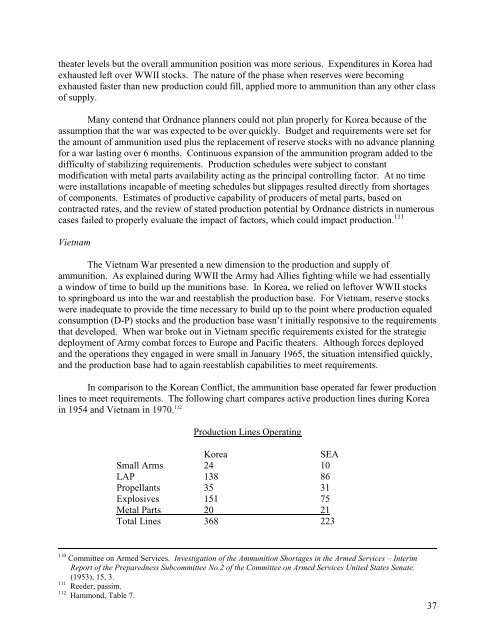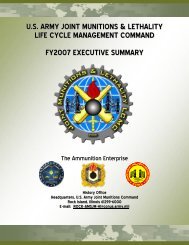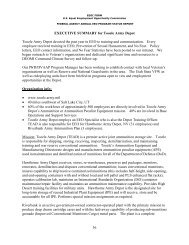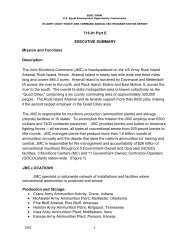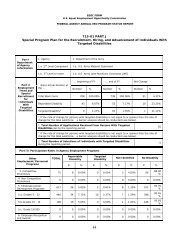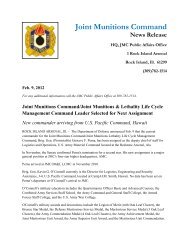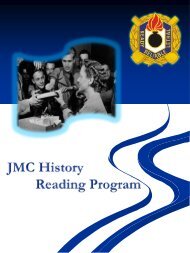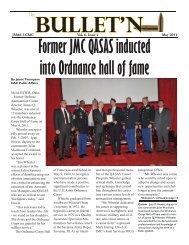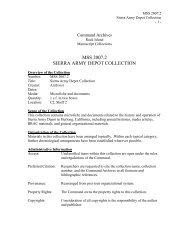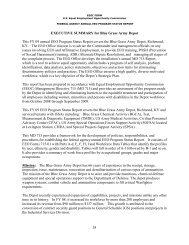History of the Ammunition Industrial Base - JMC - U.S. Army
History of the Ammunition Industrial Base - JMC - U.S. Army
History of the Ammunition Industrial Base - JMC - U.S. Army
You also want an ePaper? Increase the reach of your titles
YUMPU automatically turns print PDFs into web optimized ePapers that Google loves.
<strong>the</strong>ater levels but <strong>the</strong> overall ammunition position was more serious. Expenditures in Korea had<br />
exhausted left over WWII stocks. The nature <strong>of</strong> <strong>the</strong> phase when reserves were becoming<br />
exhausted faster than new production could fill, applied more to ammunition than any o<strong>the</strong>r class<br />
<strong>of</strong> supply.<br />
Many contend that Ordnance planners could not plan properly for Korea because <strong>of</strong> <strong>the</strong><br />
assumption that <strong>the</strong> war was expected to be over quickly. Budget and requirements were set for<br />
<strong>the</strong> amount <strong>of</strong> ammunition used plus <strong>the</strong> replacement <strong>of</strong> reserve stocks with no advance planning<br />
for a war lasting over 6 months. Continuous expansion <strong>of</strong> <strong>the</strong> ammunition program added to <strong>the</strong><br />
difficulty <strong>of</strong> stabilizing requirements. Production schedules were subject to constant<br />
modification with metal parts availability acting as <strong>the</strong> principal controlling factor. At no time<br />
were installations incapable <strong>of</strong> meeting schedules but slippages resulted directly from shortages<br />
<strong>of</strong> components. Estimates <strong>of</strong> productive capability <strong>of</strong> producers <strong>of</strong> metal parts, based on<br />
contracted rates, and <strong>the</strong> review <strong>of</strong> stated production potential by Ordnance districts in numerous<br />
cases failed to properly evaluate <strong>the</strong> impact <strong>of</strong> factors, which could impact production. 111<br />
Vietnam<br />
The Vietnam War presented a new dimension to <strong>the</strong> production and supply <strong>of</strong><br />
ammunition. As explained during WWII <strong>the</strong> <strong>Army</strong> had Allies fighting while we had essentially<br />
a window <strong>of</strong> time to build up <strong>the</strong> munitions base. In Korea, we relied on leftover WWII stocks<br />
to springboard us into <strong>the</strong> war and reestablish <strong>the</strong> production base. For Vietnam, reserve stocks<br />
were inadequate to provide <strong>the</strong> time necessary to build up to <strong>the</strong> point where production equaled<br />
consumption (D-P) stocks and <strong>the</strong> production base wasn‟t initially responsive to <strong>the</strong> requirements<br />
that developed. When war broke out in Vietnam specific requirements existed for <strong>the</strong> strategic<br />
deployment <strong>of</strong> <strong>Army</strong> combat forces to Europe and Pacific <strong>the</strong>aters. Although forces deployed<br />
and <strong>the</strong> operations <strong>the</strong>y engaged in were small in January 1965, <strong>the</strong> situation intensified quickly,<br />
and <strong>the</strong> production base had to again reestablish capabilities to meet requirements.<br />
In comparison to <strong>the</strong> Korean Conflict, <strong>the</strong> ammunition base operated far fewer production<br />
lines to meet requirements. The following chart compares active production lines during Korea<br />
in 1954 and Vietnam in 1970. 112<br />
Production Lines Operating<br />
Korea<br />
SEA<br />
Small Arms 24 10<br />
LAP 138 86<br />
Propellants 35 31<br />
Explosives 151 75<br />
Metal Parts 20 21<br />
Total Lines 368 223<br />
110 Committee on Armed Services. Investigation <strong>of</strong> <strong>the</strong> <strong>Ammunition</strong> Shortages in <strong>the</strong> Armed Services – Interim<br />
Report <strong>of</strong> <strong>the</strong> Preparedness Subcommittee No.2 <strong>of</strong> <strong>the</strong> Committee on Armed Services United States Senate.<br />
(1953), 15, 3.<br />
111 Reeder, passim.<br />
112 Hammond, Table 7.<br />
37


